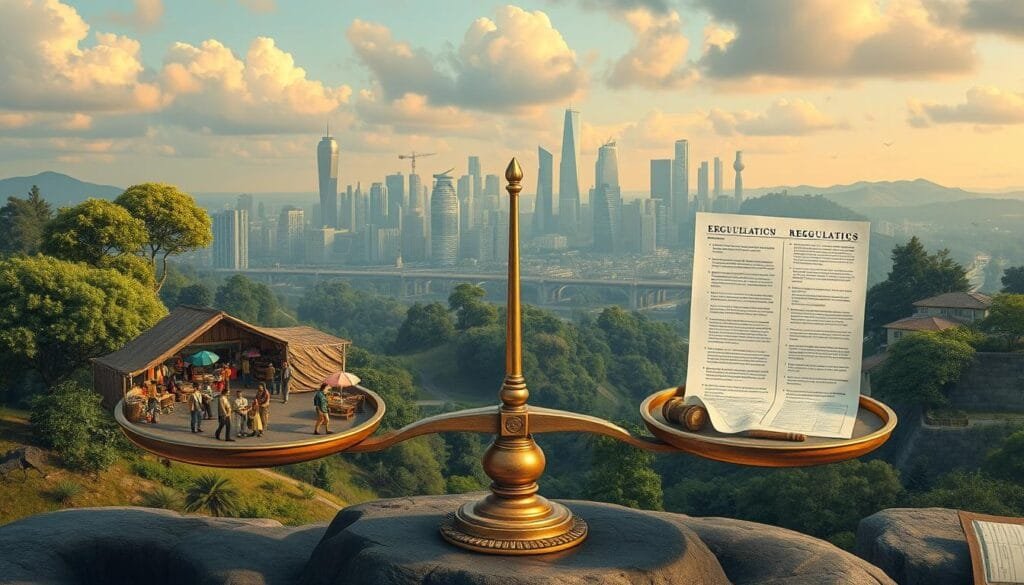Ever wonder how countries mix capitalism and socialism to make good economies? In today’s world, it’s not always clear where government actions end and private business begins. Mixed economies try to get the best from both systems. They look for ways to produce goods that foster innovation and help society.
Mixed economies blend market-driven and state-controlled elements. They aim to use resources well, sparking creativity and supporting the common good. Unlike pure capitalism or socialism, they find a middle ground. This balance works for economic growth and the health of society.
In mixed economies, there’s a fine line between free markets and rules. Governments and businesses work together through measures like wage laws and subsidies. This partnership affects the making and sharing of products. It’s essential for meeting big societal goals without holding back new ideas or market forces.
To grasp this balance, look at examples from around the world. The U.S. mixes a strong capitalist base with government programs. Western Europe also combines market competition with big social safety nets. Both show how mixed economies operate in real life.
Want more details on mixed economic systems and how they work? Read more about it here.
Key Takeaways
- Mixed economic systems blend capitalism and socialism.
- They aim for smart resource use and providing for society’s needs.
- Mixed economies feature price control and subsidies for balance.
- The U.S. and Western Europe offer examples with strong safety nets and free markets.
- Partnerships between governments and businesses fuel innovation and tackle societal issues.
Introduction to Mixed Economic Systems
Mixed economic systems combine the best parts of capitalism and socialism. They provide economic freedom through private ownership and markets. At the same time, they use government economic intervention to meet social needs and fix market failures.
The Great Depression (1929-39) led major Western countries to adopt mixed economies. During 1933 to 1939, the U.S. started the New Deal. It introduced laws and programs to fight high unemployment. This was a new direction from the old belief that free markets led to social well-being.
In 20th-century Europe, social democratic programs aimed to merge business with social groups. This helped evolve the mix of capitalism and socialism. As a result, countries like China and Russia shifted from planned economies to compete globally.
Mixed economies use government power to help balance the market. They might use subsidies, taxes, or rules. By the early 21st century, most economies were mixed. This shows their role globally and the need for a balance between freedom and state control.
Globalization has changed how governments intervene in the economy. They try to balance free trade with social welfare. Mixed economies aim to be ethical, focusing on compassion and individual rights. Leaders try to find a fair balance in their decisions.
In mixed economies, 15 to 20 percent of utilities and services are publicly owned. The history of these economies goes back to ancient times. It includes periods like Ancient Mesopotamia and the Byzantine Empire, and figures like Jean-Baptiste Colbert in 17th-century France.
The American System, supported by Alexander Hamilton and Henry Clay, shows mixed economy traits. Chiara Yates points out that most global economies today, including the U.S., are mixed. This shows how widely the model has been adopted.
Understanding the Production Process in Mixed Economies
Mixed economies mix market and command system elements, found worldwide. They use both private and public production roles. This helps keep the economy stable and growing.
The Role of Private Businesses
In mixed economies, private businesses are crucial for innovation and making money. They add a lot to the economy. In the UK, most economic activities come from private sectors like banking and insurance.
These businesses work under government rules. These include laws for the environment, work conditions, and fair competition. This ensures they operate sustainably and compete fairly.

Private companies also drive consumer trends and match supply with demand. Their ability to change helps the economy grow. It leads to better living standards by providing various products and services. The UK’s new trade deals after Brexit show how vital private firms are for reaching new markets.
Government Intervention in Production
While private sectors focus on innovation, governments balance the economy by dealing with market failures. They might run state-owned businesses or use policies and regulations. In the US, the government supports areas the private sector ignores, like education and protecting the environment.
Government rules in mixed economies protect the public. They cover minimum wages, competition laws, and green policies. These measures aim for a stable environment where businesses and public services can grow. Governments also use fiscal policies to control economic growth.
Public-private partnerships are key, blending private efficiency with public goals. These partnerships are common in projects like building infrastructure and healthcare. They help deliver important services well.
This blend of private initiative and government strategy promotes stable, inclusive growth. It benefits the entire economy.
How Do Mixed Economies Produce Goods?
Mixed economies find a balance between market forces and regulations. This balance helps to manage production. Nations use this method to find a middle ground between freedom and rules. This allows for both structured and flexible economic activities.

Balancing Market Freedom and Regulation
Mixed economies depend on both the market and regulations. The market decides how resources are shared. But rules make sure important areas aren’t fully controlled by the market. For example, the United States lets the technology sector run with little interference.
Yet, it keeps a tight check on utilities and healthcare. This approach shows how mixed economies work. They balance market freedom with government control. This helps in maintaining stability and supporting growth.
Examples of Government and Private Sector Roles
Different mixed economies show how government and private sectors play their parts. In the UK, people can start businesses easily. But, in sectors like aerospace and banking, both government and private ownership exist. Prices are mainly set by the market. However, the government steps in crucial sectors to stop monopolies. This ensures everyone has fair access to services.
| Country | Sector | Role of Government | Role of Private Sector |
|---|---|---|---|
| United States | Technology | Minimal Interference | Innovation |
| United States | Utilities | Heavy Regulation | Management and Operations |
| United Kingdom | General Business | Robust Property Rights | Entrepreneurship |
| United Kingdom | Banking | Regulated Oversight | Capital Investment |
Looking at these examples helps us see how mixed economies work. Countries like Norway and Sweden are often seen as welfare states. They show how governments can control the economy in a mixed economy. Mixed economies aim to blend market efficiency with fair government rules.
Advantages and Disadvantages of Mixed Economies
Mixed economies mix capitalist growth with socialist safety nets. This approach drives innovation and growth while providing essential services. It cuts income inequality. These economies use both private investment and government planning to keep the economy stable and efficient.
The blend of private and state efforts creates synergy. Private firms boost competition and profits. Meanwhile, government provides tax-funded education, healthcare, and infrastructure. The U.S. showcases this system well. It combines market freedom with government support, especially in agriculture.

Mixed economies offer fairer resource sharing than pure capitalism. They lower income gaps and improve access to key services. Libraries, schools, and hospitals are within reach for more people. Governments run programs to aid the economy and support the needy.
Yet, mixed economies face challenges. Too much government can twist markets. Over-regulation might hinder entrepreneurs and innovation. Big businesses might sway policies to gain unfair advantages, affecting market balance.
Finding the right market and welfare balance is tricky. Too much control may slow growth and build debt. Still, mixed economies try to sidestep the flaws of pure markets, especially in vital sectors.
The goal is to match private sector energy with effective government regulation. This ensures growth, fairness, and stable markets.
Conclusion
Mixed economies can look forward to a bright future if they keep updating their rules and the balance between freedom in the market and government control. For sustained growth, it’s crucial for governments to find the perfect balance. This balance helps in combining the best of both private and public sectors.
Across the globe, mixed economy models differ greatly. For example, Iceland uses about 57% of its GDP on public services, while Sweden uses 52%. This shows a strong government role in these countries. On the other hand, Hong Kong spends only 18.6% of its GDP this way, preferring less government interference. These differences show how mixed economies can be customized to meet a country’s specific needs.
At the end of the day, the success of mixed economies depends on their ability to be flexible and innovative. They need to balance the growth driven by the market with smart government actions. This can help avoid problems like inflation and economic inequality. Given the growing challenges like climate change, mixed economies are well-positioned to adapt and thrive, ensuring a brighter future for all.
FAQ
What is a mixed economic system?
A mixed economic system blends capitalism and socialism. It supports private property and market-driven businesses. At the same time, it uses government action to reach social objectives and fix market issues.
How do mixed economies benefit from the involvement of both private and public sectors?
Mixed economies benefit from the private sector’s efficiency and innovation. They also use government rules and actions to promote welfare and fairness. This mix can lead to growth and safeguard public interests.
What are some examples of government intervention in mixed economies?
Government steps in through regulations, social programs, and controlling key sectors. It sets environmental standards and laws about work and competition.
How does the private sector contribute to production in mixed economies?
The private sector focuses on making profits and being innovative, within rules set by the government. It follows environmental, labor, and competition laws.
Can you give examples of countries with mixed economic systems?
The United States, Canada, and many European nations have mixed economies. They mix minimal intervention in some areas with strong rules in utilities and healthcare.
What are the main advantages of mixed economies?
Mixed economies push for innovation and growth, ensuring everyone has access to key services and reducing the gap between rich and poor. They blend the best of capitalism and socialism.
What are some disadvantages of mixed economies?
Downsides include the risk of too much government control, altered markets due to strict rules, and the challenge of keeping markets efficient while also addressing welfare needs.
How do mixed economies balance market dynamics with regulatory frameworks?
Mixed economies aim to let market forces work but set rules to avoid problems and failures. They balance economic freedom with government checks.
What is the role of public-private partnerships in mixed economies?
Public-private partnerships bring together government and business to provide services or build infrastructure. They combine private sector’s innovation with public sector accountability.
What is the future outlook for mixed economies?
The success of mixed economies will depend on adapting to new economic conditions. Achieving the right mix of market freedom and regulation is crucial for facing global issues.
